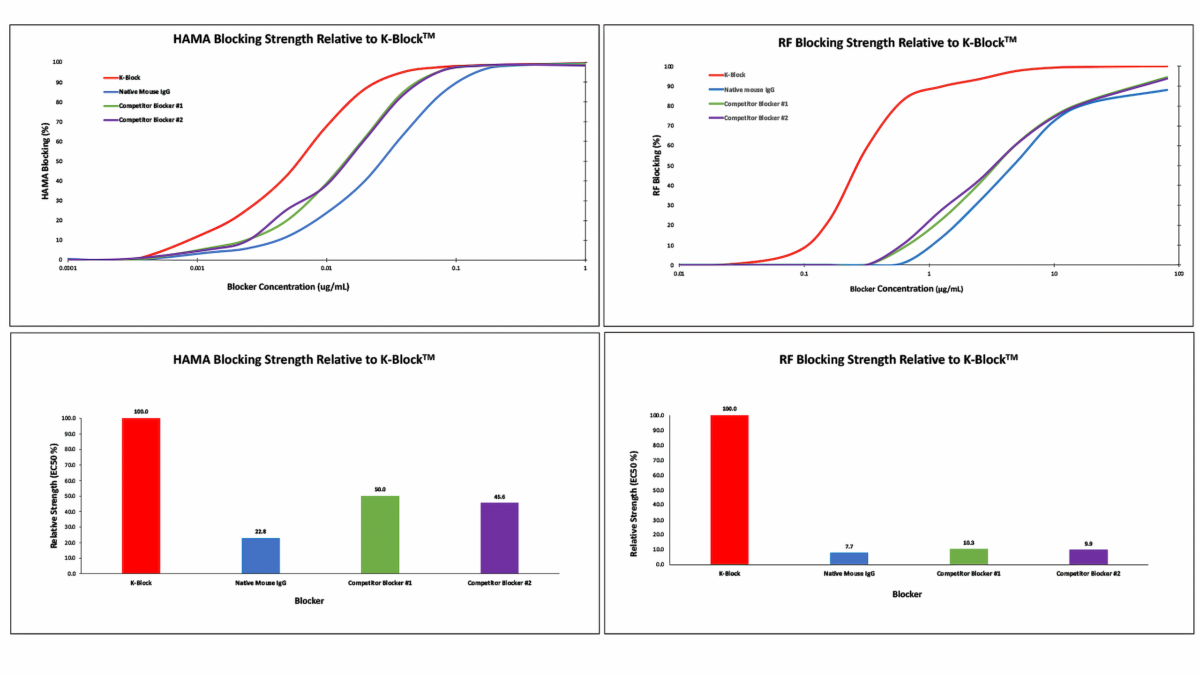Animal-Free Immunoassay Blockers
Immunoassay interference blockers are critical to assay sensitivity. In double mouse monoclonal assays, interference blockers are required to remove cross-reactive HAMA and RF. These blockers are usually produced using animal sources – Meridian’s new blockers, K-Block™ and Mouse-Free IgG are 100% animal-free.
Proven Results for IVD
Immunoassay blockers are used in diagnostic assays to reduce non-specific binding and other interference that can lead to false-positive results. Meridian’s newest solution, K-Block is the first commercially available, animal-free interference blocker that has proven high performance against similar animal-based commercial HAMA blockers.
A double mouse monoclonal sandwich assay was used to compare the performance of Meridian Bioscience’s K-Block (100% animal-free, recombinant blocker, MLS Cat. No. BN1200) against serum-derived purified native mouse IgG and two competitor recombinant mouse IgG HAMA blockers. (A) Human HAMA-positive or (B) RF-positive serum was preincubated with the individual blockers for 20 minutes at room temperature. Blocker concentrations ranged from 0.0001-1.25 µg/ml for the HAMA assay and 0.01-80 µg/ml for the RF assay. The effectiveness of each blocker was determined by comparing the relative suppression of the HAMA signal to the signal of samples with no blocker. The results demonstrate that at higher concentrations K-Block is as effective as the other blockers and at lower concentrations, K-BlockTM was more effective than native mouse IgG and the two competitor’s recombinant HAMA blockers.
Top 5 Advantages of Using an Animal-Free Blocker
Enhanced specificity:
K-Block offers improved specificity over traditional blockers, as it will not cross-react with animal-sourced antigens and antibodies in the assay. The potential for non-specific binding is reduced and the signal-to-background is improved.
Consistent performance:
Animal-derived reagents can have batch-to-batch variability, impacting assay consistency. In contrast, animal-free reagents are more chemically well-defined and contain a finite number of traceable ingredients, resulting in regulatory advantages and increased speed-to-market.
Ethical considerations:
Using an animal protein-free blocker aligns with the ethical concerns related to using animals in science.
Regulatory compliance:
Regulations such as the European Union (EU) Directive2010/63/EU, are encouraging the use of animal-free reagents. Reduced risk of contamination: Animal-derived components used in traditional blockers can carry contaminants, such as viruses, prions, and endotoxins, that can affect the accuracy of an assay. K-Block eliminates this risk as it is animal-free.
Reduced risk of contamination:
Animal-derived components used in traditional blockers can carry contaminants, such as viruses, prions, and endotoxins, that can affect the accuracy of an assay. K-Block eliminates this risk as it is animal-free.
产品资料
Meridian K-Block CatalogMeridian K-Block Catalog
Mouse-FREE IgGMouse-FREE IgG
Product Specifications
K-Block Animal-Free Immunoassay Blocker
Catalog Number: BN1200
BN1200 Certificate of Analysis (COA)
Mouse-free Animal-Free Immunoassay Blocker
Catalog Number: BN1300
Frequently Asked Questions
Immunoassay Interference Blockers
For best performance, the blocker should be included as part of the sample or conjugate diluent. In lateral flow assays, the HAMA blocker may be added to the conjugate pad, to a sample diluent or pretreatment buffer, and/or applied to the membrane as a blocking stripe located before the test stripe.
For diluted samples, K-Block should be used between 0.5 µg/ml and 20 µg/ml. For non-diluted samples, K-Block should be used between 5 µg/ml and 200 µg/ml final concentration.
Mouse IgG can be added up to 10X the concentration of the monoclonal antibody being used in the assay to increase blocking effectiveness.
Mouse IgG can be added up to 10X the concentration of the monoclonal antibody being used in the assay to increase blocking effectiveness.
Mouse-Free IgG is 20% more effective than standard Mouse IgG at blocking HAMA/RF/HA.
Request A Sample
Animal-Free Immunoassay Blockers
Please fill out the form about your inquiry. Upon submission, a member of our team will be in touch with a quote for your product sample.
